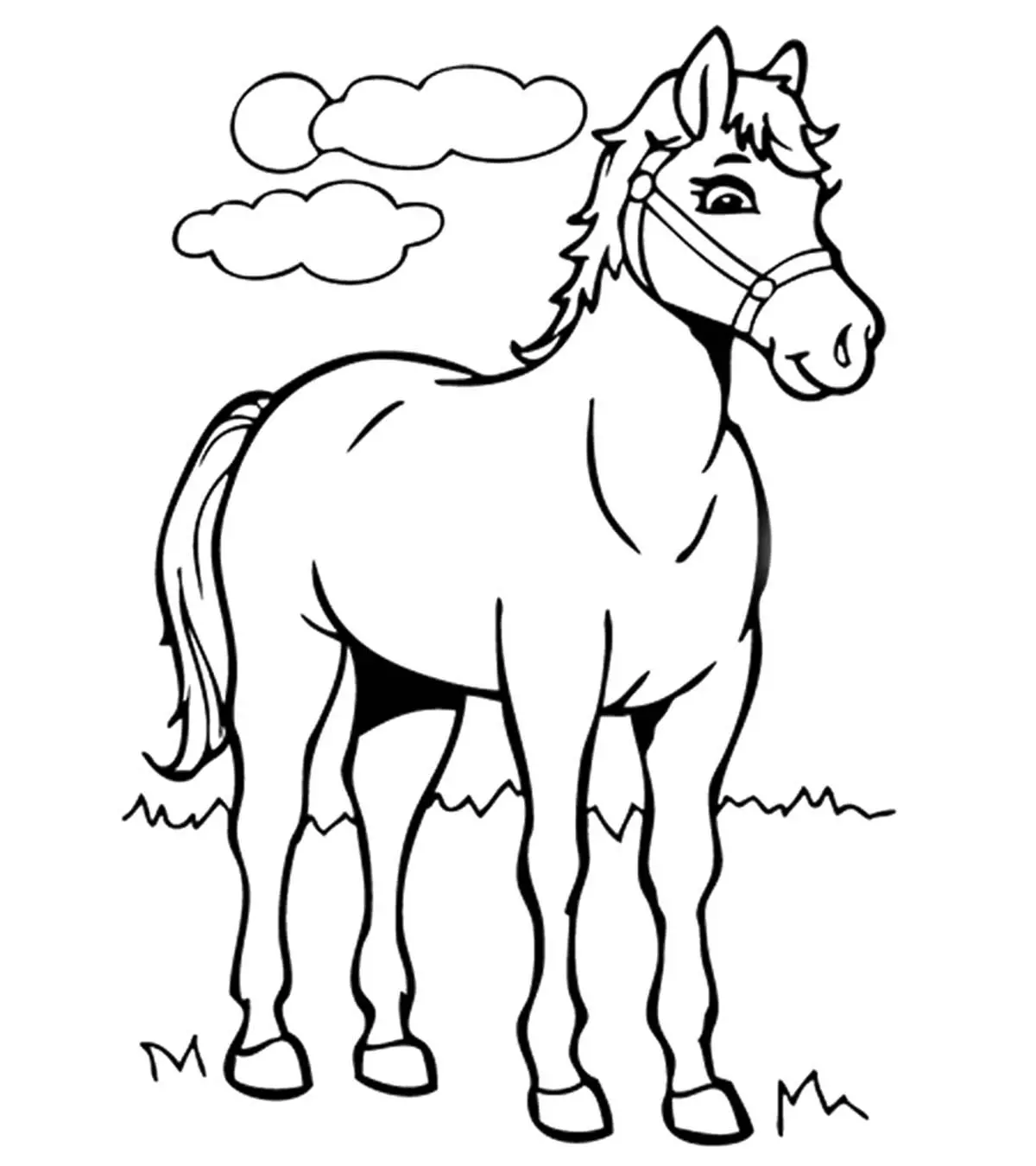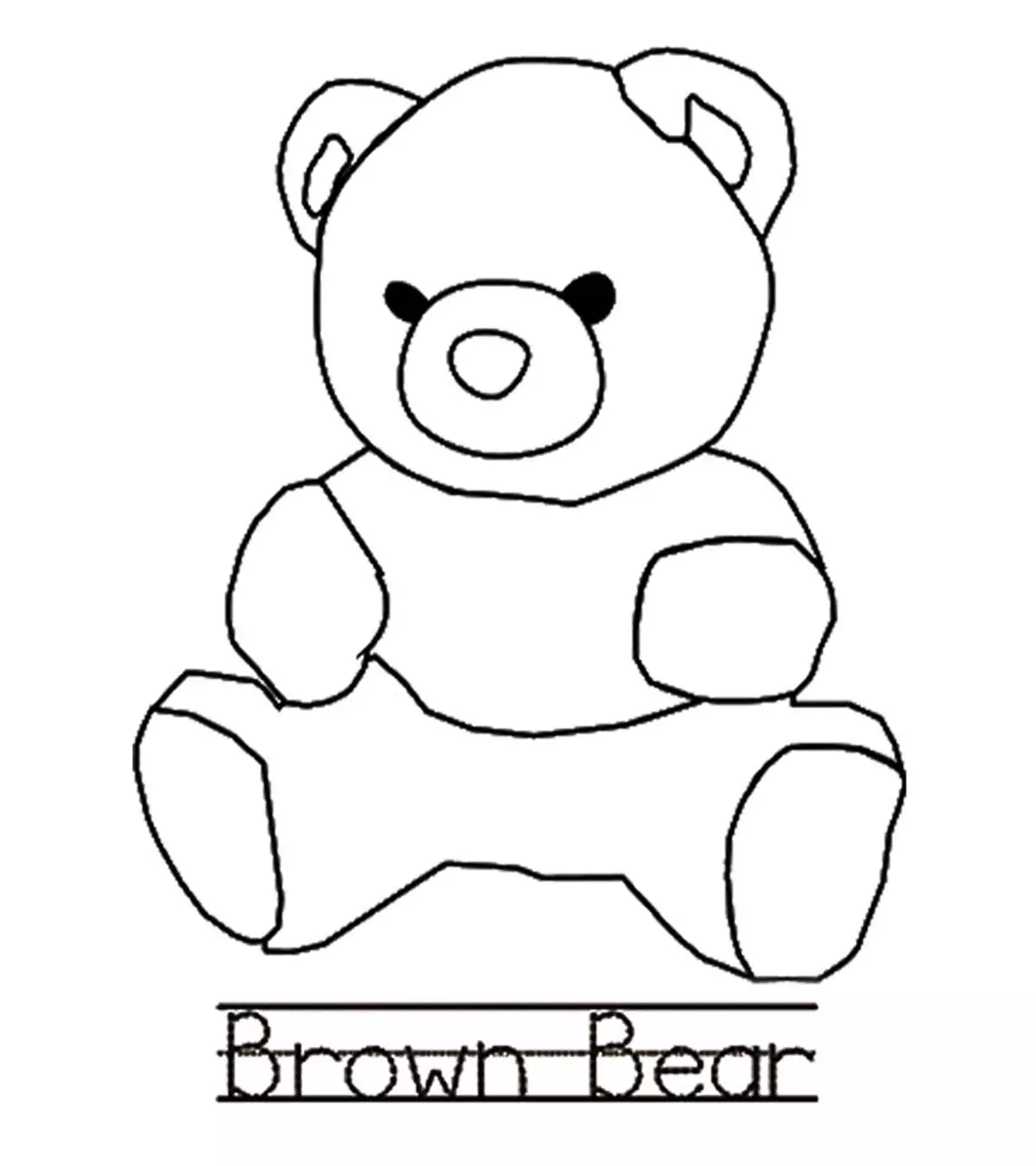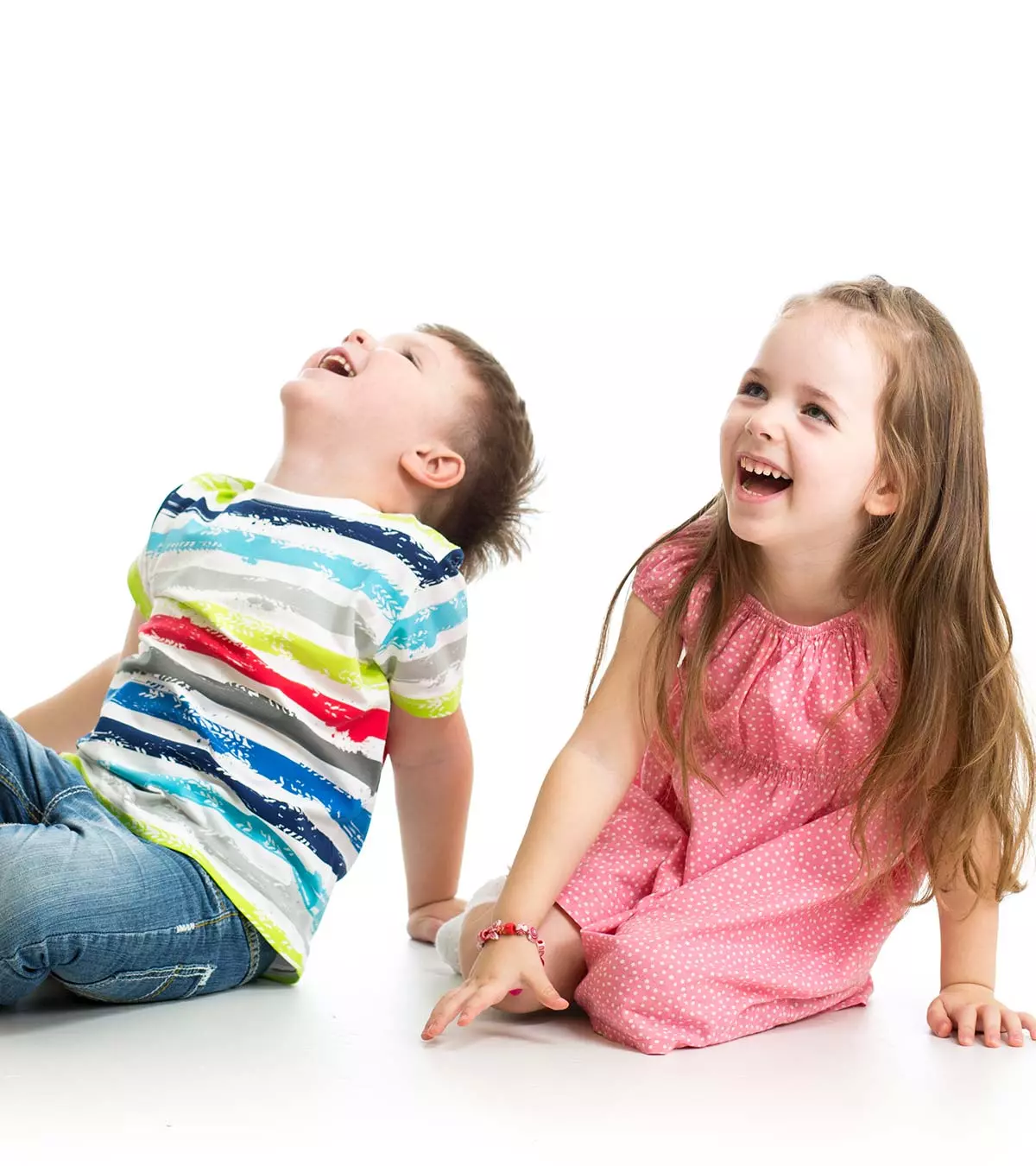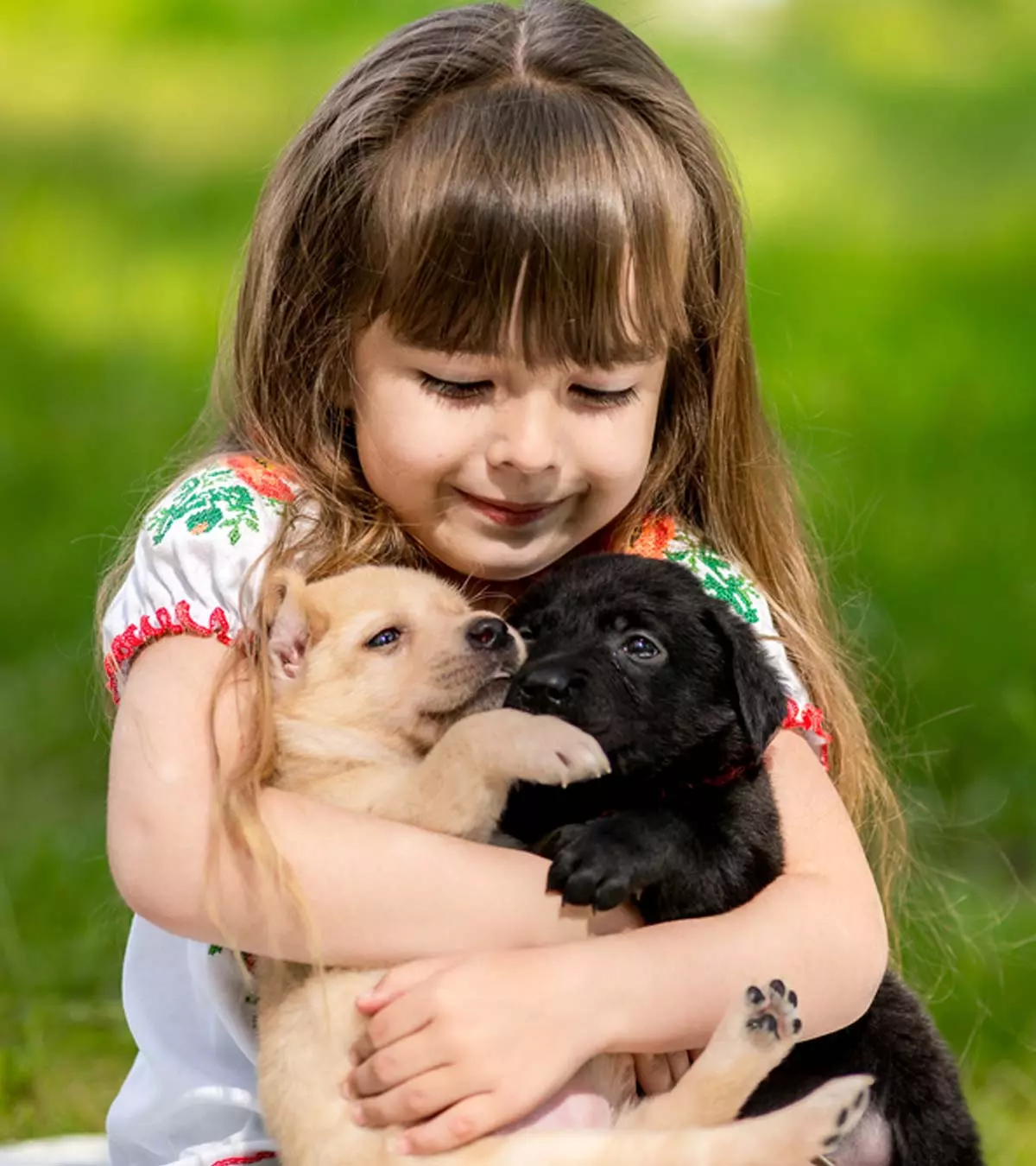
Image: Shutterstock
A child can find a true companion in a pet. If you plan to identify the best pets for kids, reading this post can help you. Growing up with this non-human friend can effortlessly instill the virtues of love, compassion, and care in your child. Pets make children more responsible in their actions and empathetic towards others. According to the American Academy of Child and Adolescent Psychiatry, children who demonstrate patience and compassion when caring for pets often carry these qualities into their relationships with others (1).

However, it is important to pick up the right pet to match your child’s personality and your family’s convenience. It includes sticking to the docile critters and preferably avoiding the wild animals. Again, your child’s pleasure should not cost the animal its freedom. Keep reading this post where we have compiled a list of different animals and the pros and cons of having them as pets.
Key Pointers
- Domesticated dogs, including golden retrievers, labrador retrievers, and poodles, can be the best pets for kids
- Fish is low maintenance, a distant companion, and probably the best first pet for children.
- Cats can also be good companions. However, they can be moody and defensive at times.
12 Best Pets For Children
1. Dogs

“Sometimes you do not need words to feel better; you just need the nearness of your dog.” – Natalie Llyod
Domesticated dogs make excellent pets and hence a common choice among pet lovers. Depending on their availability and suitability in your region, there is a wide range of puppy breeds to explore. Prefer dog breeds that are kid-friendly and socialize easily. Some of the breeds that are known to be great companions for children are Labrador Retrievers, Golden Retrievers, Pomeranians, and Poodles.
Advantages
- Dogs are known to turn the environment playful and relax the mood.
- Dogs are often sensitive to their owner’s or child’s mood. They can often bring comfort when a child is distressed or anxious.
- Playing with them requires running around the house that can keep your child active.
- They are known to stay loyal to their owner.
Bella Bucchiotti, a lifestyle blogger passionate about dogs and food, recounts her experience with her dog Beau and the life lessons Beau imparted to her. She says, “Beau taught me to enjoy the little things. But more than that, he taught me to enjoy everything! As much as I possibly can! He never gets tired of treats, walks, or our afternoon naps. He never gets bored with his favorite ball. He’s definitely one to indulge in his favorite things over and over. Seeing how happy that makes him has inspired me to do the same! More walks! More movies! (i).”
Disadvantages
- Dogs require training that involves significant time and effort.
- They warrant proper care and attention from their owner. If you leave a domestic dog alone, they start feeling lonely.
- Regular visits to the veterinarian are necessary for immunizations to maintain their health.
- They might bite accidentally, especially when irritated.
- Some dogs, such as Akita (guard dog), tend to turn aggressive when teased. Thus, they must be avoided as pets in families with young children.
Habitat and diet: Dogs need a comfortable and secure indoor space with a bed and access to outdoor play areas for walks, exercise, and routine activities. Provide fresh water and a balanced diet that includes protein, fats, and carbohydrates based on the dog’s age, size, and breed (2).
 Point to consider
Point to consider2. Cats
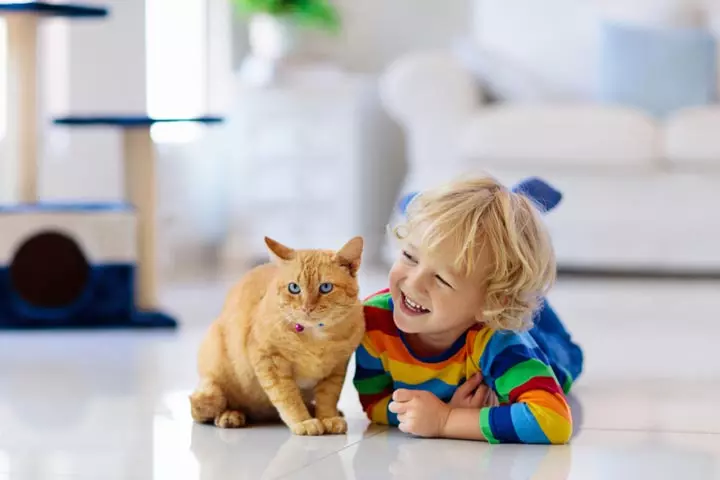
“Time spent with cats is never wasted.” – Sigmund Freud
Cats and kittens are adorable animals loved for their independent nature. They are a better choice for your child if you do not have ample living space. However, be aware of their strong-will, which makes it challenging to handle at times. Some kid-friendly cats that you could consider are Abyssinian, Burmese, and Maine Coon.
Advantages
- Cats play with themselves often. Their hunting instinct makes it easier to play several games with them.
- Their naughty behavior can keep your child engaged by keeping the mood playful.
- When compared to dogs, most cat breeds need less attention and time.
Disadvantages
- The biggest drawback of having cats is that they can be extremely moody and defensive. When in rage, they might scratch or bite.
- They tend to spread allergies more easily than dogs.
- Their independent nature can cause them to wander away. They do not like to stay in one place for long.
Habitat and diet: Create a safe, dry, and comfortable environment where cats can rest, hide, and play (such as under the stairs). Regularly clean the litter box and change the bedding. Cat food should generally be high in protein and fat and low in carbohydrates (2). Cooked chicken and pureed carrots are good options.
3. Fish
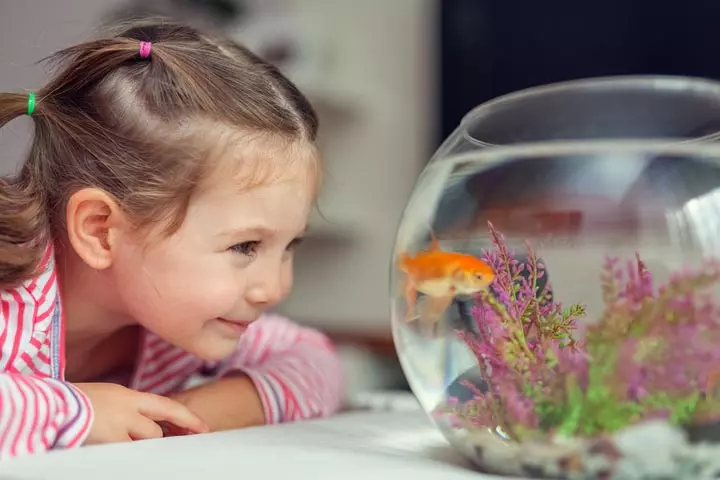
“People in grief need someone to walk with them without judging them. So they keep fishes in aquarium.” – Anonymous
A fish is a calm, distant companion and a great starter pet that your child would love. Their colorful appearance and gentle movements are visual treats that can be calming to your child. But, while selecting a fish, stay informed of their specific needs. Some fishes need more care than others. Thus, buy fish from a reputable store where an expert can guide you about the right fish type to pet and the care it warrants.
Advantages
- They are quiet, calming, and fascinating to watch, especially for young children.
- They can be a great option for children who prefer to watch rather than interact with a pet.
- Their swimming skills can amuse and may even come across as educational for older children.
Disadvantages
- Inability to touch, cuddle, and pamper a fish may be upsetting for some children.
- Fishes need the right kind of food in specific quantities.
- Cleaning and maintaining a fish tank requires time and effort. It ensures that they survive longer in a human-made habitat.
Habitat and diet: Keep the fish tank water clean, covered, continuously filtered, well-spaced (based on the number of fish), and free from chlorine. Add plants and decorations to provide hiding spots and natural oxygen (3). Feed with species-specific flakes or pellets once or twice daily and supplement with live or frozen food.
4. Birds

“The reason birds can fly and we can’t is simply because they have perfect faith, for to have faith is to have wings.” – J.M. Barrie
Birds are colorful, independent, and flying is essential for them. Caging them may not be a good idea. For children, birds are an amusing and enjoyable sight. Therefore, if they wish to have a bird, instead of caging, motivate them to have an open birdhouse. You can keep this on your terrace or in the garden. Some of the safe and friendly bird species that your children can have are parakeets (budgies), parrots, quaker parrots, canaries, lovebirds, cockatoos, cockatiels, and parrotlets.
Advantages
- Birds are entertaining and amusing for children, especially young children who like to watch them fly.
- They are known to be safe for children as they seldom bite or scratch.
- They are low on maintenance due to their minimal diet and general care needs.
Disadvantages
- Some birds can be noisy and messy, so you need to be careful with young children around.
- Handling and training birds require time and patience.
- Cleaning their cage is a tedious task that you must do at least two to three times a week to prevent the spread of any allergy or infection through bird droppings.
- Uncaged birds can nibble on furniture. Thus, keeping them in the open, outside the house is a good practice.
Habitat and diet: Arrange a birdhouse with enough space for perches, toys, and feeding cups. Place the cage or house in a well-ventilated and lit area, avoiding direct sunlight. Ensure it is covered at night (3). The type of food varies depending on the bird type and beak size and could include seeds, pellets, fresh fruits, and vegetables.
5. Rabbits
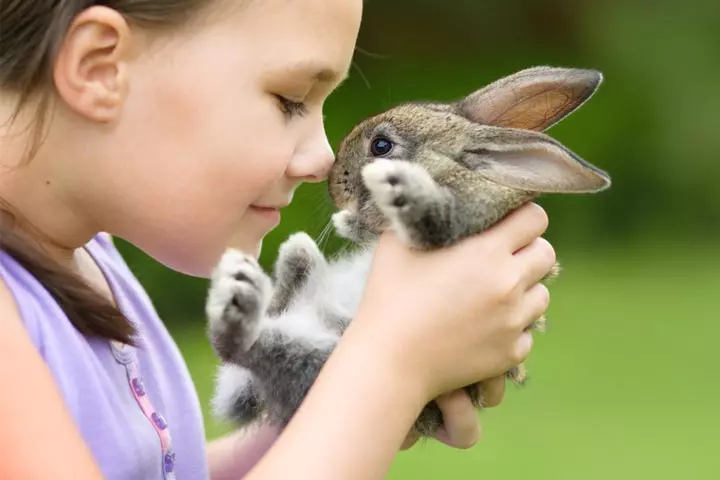
”A rabbit living with you is not weird, it’s truly wonderful.” — Unknown
From cartoons to real life, rabbits, much fondly called “bunnies” are lovable creatures. These cute little tame and tender animals move swiftly and like to stay in the wild. Rabbits are a good option if you have a lawn or garden where they can play around.
Advantages
- They are entertaining for children who like to watch them hopping around.
- In general, rabbits are safe for children, especially older ones, who are aware of the techniques to hold a rabbit carefully.
- They are low on maintenance as they do not need any specific training or special food to eat.
Disadvantages
- Young children need guidance to handle rabbits as they are sensitive.
- Can bite or scratch sometimes; so you need to be watchful when children are playing with rabbits.
- Their pen needs almost daily cleaning to ward-off the smell from their excretions.
- If you have a dog or a cat as a pet, then rabbits need extra vigilance as they might get preyed upon.
Habitat and diet: For a rabbit’s house, you need a hutch with soft hay bedding. Ensure you provide ample space on the lawn for it to rest and hop around. A rabbit’s diet usually consists of hay, carrots, fresh greens, pellets, and fresh water (4).
 Do remember
Do remember6. Hamsters

Hamsters are small, furry, inquisitive mammals that children will love to pet. They are considered one of the best small pets for children. However, these tiny creatures are solitary and get frightened easily by sudden movements and loud noises. Thus, with young children in the house, tending hamsters might get tricky.
Advantages
- They are affordable and inexpensive. However, that depends on the species that you select.
- Some hamsters are social, while some others are not. But, in general, hamsters demand relatively less attention than cats and dogs.
- They do not require any specialized training as they mostly stay in their pen and prefer to play with toys like chew, igloo, or hammock.
- They do not need a large living space due to their small size.
Disadvantages
- Hamsters often nap during the day, and if awakened suddenly, they may bite. Thus, proper care is required if you have young children at home who could tease a hamster.
- Children under eight years are recommended to tend to hamsters under parental guidance.
- A pair of hamsters can be a mess as they might fight and inflict injuries on each other.
Habitat and diet: Hamsters require a sturdy cage with a secure lid and a removable bottom for ventilation and easy cleaning. Use dust-free bedding materials like peanut hulls or shredded paper (3). For their diet, provide hamster feed, pellets, grains, vegetables like lettuce, carrots, and celery, and fresh, clean water.
7. Guinea pigs
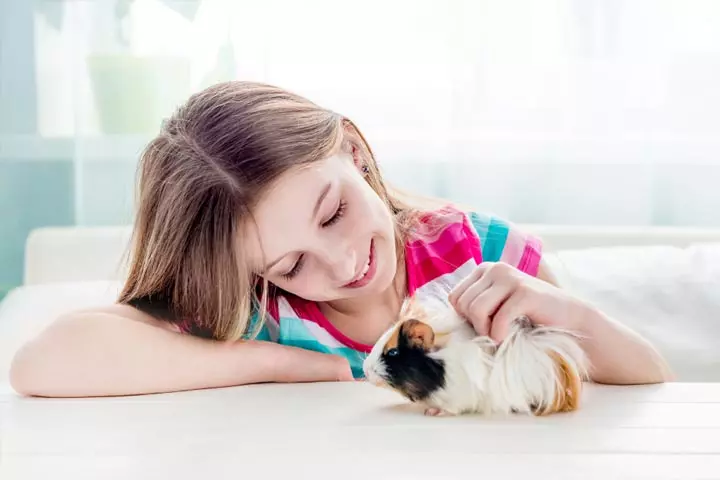
“I have a cat. When I was younger, I had a guinea pig.” – Alison Goldfrapp
Guinea pigs are a popular choice for pets partly because of their furry cute looks that are likely to appeal to children. The animal does have some specific needs in diet, which mostly consists of hay, grass, fruits, and vegetables.
Advantages
- Responds to your child’s actions and turns the environment playful.
- They are less skittish than smaller rodents.
- They rarely bite, so they are considered relatively safe for young children.
Disadvantages
- Spot-cleaning its hutch needs to be done several times a day as they poop a lot.
- Constant trimming is required as their nails grow fast.
- Being a social animal, they need at least one guinea pig as a companion.
- They require ample space to live. Keeping them in small pens can make them fussy and irritated due to restricted activity.
Habitat and diet: Create a cozy cage with hay and soft bedding and provide small hiding spots. Guinea pigs enjoy eating hay, pellets, herbs, and fresh vegetables such as cilantro, peppers, or carrots (5).
8. Turtle

“Try to be like the turtle – at ease in your own shell.” – Bill Copeland
Turtles are a common pet in many homes. Children often pick them up from beaches and keep them in glass bottles or plastic boxes. However, it is best to pick turtle bred for being kept as a pet to avoid the spread of pathogens from a wild turtle. Also, a domestic home is not the right place for wild turtles to survive.
Advantages
- They are appealing to children who love to watch them amble.
- They like to stay in one place for longer, so you or your child does not have to run after them.
Disadvantages
- They are a potential source of salmonella bacteria. This risk can be mitigated by purchasing only human-bred turtles from reputable pet stores.
- Turtles should never be left loose as they end up crawling outside the house, on the road, or to other places where there is a risk of injury.
- They need specialized care throughout life as they are not growing in their natural habitat.
Habitat and diet: Turtles require both land and water environments. Use an aquarium, pond, or paludarium with twigs, small rocks, water lilies, and land plants, and create a safe space on land with durable materials like wood, stone, or mesh. As omnivores, turtles eat meat, leafy vegetables, and fruits, which can be provided two to three times a week (3).
9. Rats

Rat as a pet may not be everyone’s choice, but some children do not hesitate to pet a rat. Rats are related to guinea pigs, and thus can show several similar behavioral attributes that make them great pets for children.
Advantages
- Intelligent, friendly, and affectionate that makes them fascinating for children.
- They are easy to train. Children love to train them to sit on a toy car or walk over a toy bridge.
- Rats can be sensitive to their owner’s emotions. They can be a source of calming as well as cheer from their funny antics.
- They keep themselves clean and groomed, unlike many other animals.
- They do not require a large space to live.
Disadvantages
- You need to be alert and vigilant while keeping a rat if you already have a cat or a dog at home.
- Being a nocturnal creature, they tend to move and make noises at night that can be disturbing.
Habitat and diet: A rat’s habitat should provide ample space for climbing, playing, and hiding. Use dry, well-ventilated bedding made from materials like shredded paper, coconut fibers, and wood shavings. Rats can be fed cereal grains, seeds, nuts, and fruits such as berries, grapes, and apples (3).
10. Hermit crab
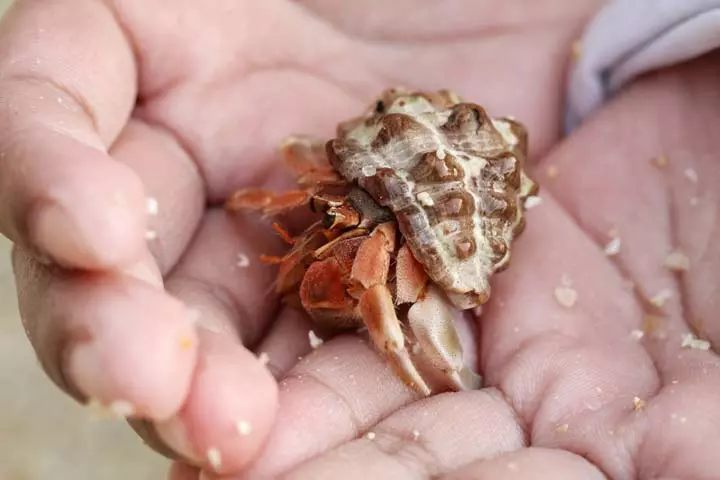
Keeping a hermit crab as a pet is a surprising choice for parents. However, these active and curious arthropods are popular among children. Before you get a hermit crab as a pet to your child, consider the poor survival rate of hermit crabs outside the wild .
Advantages
- These silent creatures are easy to care for and low on maintenance.
- They do not make noise and do not require constant attention.
Disadvantages
- Need a specific humidity level to survive. In areas with low humidity, hermit crabs do not survive.
- They cannot molt properly in captivity. For molting, they need sand that is dense and damp to burrow.
Habitat and diet: Hermit crabs thrive in a terrarium with a humid environment and controlled temperatures. Fill it with sand or gravel, and add climbing objects to let them stay active. Feed them cornmeal, oatmeal, grains, leaves, fruits, and vegetables (3).
11. Brine shrimp
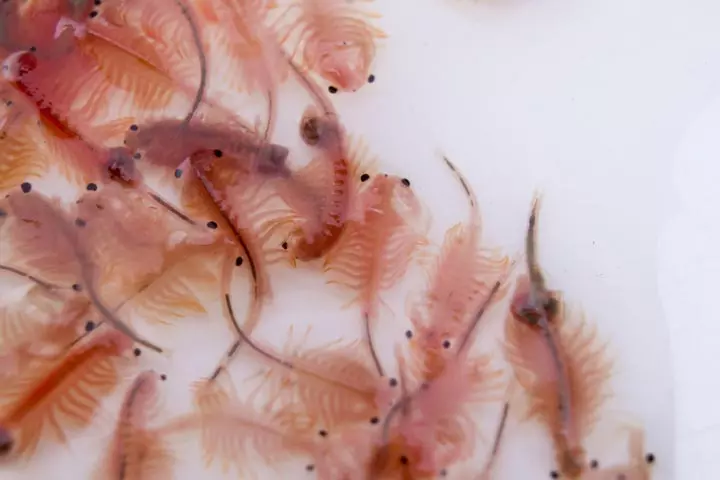
Brine shrimps or sea-monkeys are tiny aquatic creatures that are easy to care for and inexpensive. Just like fishes, they need to be kept in an aquarium or fish tank where your young child can watch them grow.
Advantages
- Brine shrimps are low maintenance until they grow into an adult.
- These small creatures do not make noise.
- They do not require constant attention.
Disadvantages
- You need to frequently change the water in the fish tank as brine shrimp is sensitive to water quality.
- The eggs of brine shrimp require constant light for hatching.
- If the tank gets overcrowded, shrimp die.
Habitat and diet: Brine shrimps are usually grown in a well-lit aquarium with brine water and a heater. They should be fed small amounts of specific food such as algae, yeast, or store-bought brine shrimp feed (6).
12. Chinchilla

Adopting a chinchilla as a pet can be a delightful experience. These creatures are larger than hamsters and rats and have a longer lifespan, making them a unique and exotic choice. They require a clean cage, food, chew toys, and a well-maintained room temperature.
Advantages
- Chinchillas have simple dietary needs, and their cages don’t require daily cleaning.
- They are social animals, forming strong bonds with owners and other chinchillas.
- Chinchillas enjoy toys, climbing, and exercise, making them entertaining pets.
- Chinchillas can live up to 20 years with proper care.
Disadvantages
- Regular dust baths, which can be messy, are necessary for coat health.
- Chinchillas can become anxious around other animals, such as dogs, cats, and rabbits.
- They are more active at night, which might disturb your sleep.
- Their diet can trigger allergies in some owners.
Habitat and diet: Chinchillas need a cozy wooden or spacious metal mesh cage kept in a dry, airy room. Feed them store-bought chinchilla or rabbit pellets, and add small pieces of fresh fruits or veggies for variety (3).
It is necessary to supervise interactions between children and pets, especially with younger children. Teach them how to respect the pet’s space and handle them gently to foster a safe environment for both. This ensures a positive and healthy relationship between children and pets.
Essential Tips For Pet Care
Although there are numerous benefits to having a pet for your child, it is vital to implement a few precautionary and supportive measures to ensure your child’s little friend is well cared for, safe, and comfortable. Here are some tips for caring for your pet (8) (9).
- Provide a safe environment free from other harmful animals, toxins, and hazards.
- Regularly clean their living space and bed, ensuring they have enough room and a comfortable temperature.
- Consider the age and health status of the pet to understand its dietary needs and provide a balanced diet and fresh water.
- Ensure regular bathing and grooming, including washing and trimming the nails, to keep your pet clean and comfortable.
- Offer appropriate toys and activities to keep the pet mentally and physically active and prevent boredom.
- Schedule regular visits to a veterinarian for vaccinations and personalized advice on your pet’s requirements, and monitor its overall well-being.
- Spend quality time with your pet to make them feel loved, secure, and free to express themselves.
Although these are the best pets for kids, choose your child’s furry companion based on their personal preferences. Since pets are long-time companions, understand that a huge responsibility would also fall on you. Their adoption may hinder your daily chores and your freedom. Hence, if you wish to adopt a pet, be ready to take up the responsibilities that come with them.
Frequently Asked Questions
1. Which pets can be left alone for a week?
Fish, hermit crabs, turtles, ducks, tarantulas, and hamsters are some pets that can be left alone in the house for a week or so. However, it’s not advisable. Ideally, you should not leave a pet alone. In case you have to do so due to unavoidable circumstances, you should keep them with some family members, friends, or in foster care centers for pets.
2. What is the most popular pet in the world?
Dogs and cats are considered the most popular pets in the world. According to the American Veterinary Medical Association (2017-2018), about 38.4% of households in the US own dogs, whereas 25.4% of households own cats and only 2.8% own birds (10).
3. Should children with ADHD have pets?
Allowing children with ADHD to have pets can be beneficial. Pets can provide companionship and love and teach responsibility. However, it’s crucial to evaluate the child’s capability to care for a pet and ensure adequate support and supervision for the safety and well-being of both the child and the pet (11).
4. At what age should a child get a pet?
The appropriate age for a child to have a pet differs depending on their maturity, sense of responsibility, and capability to care for an animal. It is recommended to assess a child’s readiness and involve parental guidance when considering pet ownership at an age where they can understand and actively contribute to its care (12).
5. Can a child with allergies still have a pet?
A child with allergies can have a pet by implementing suitable strategies to manage their allergies. This could entail choosing pets that are hypoallergenic or have lower allergenic properties, as well as adhering to medical guidance to reduce allergen exposure (13).
6. Which pets are suitable for children with allergies?
When choosing a pet for children with allergies, it’s important to consider hypoallergenic options. Fish are a popular pet choice, offering children the chance to learn responsibility while enjoying the beauty of an aquarium. Reptiles such as small snakes, lizards, or turtles offer another non-furry option. Birds like parrots or canaries can also be entertaining. Hamsters, while not hypoallergenic, spend time in enclosed habitats, reducing dander. Hypoallergenic dogs and cats, like Portuguese water dogs or sphynx cats, are great alternatives for allergy sufferers (14).
7. Should I adopt a pet from a shelter or buy one from a breeder?
Choosing between adopting a pet from a shelter or buying one from a breeder is a personal decision. Adopting from a shelter gives a home to a deserving animal in need, while buying from a breeder offers more control over the breed. Consider your values, preferences, and the pet’s needs before making a choice.
Infographic: Benefits Of Having Pets At Home
Owning a pet is a great responsibility, and it helps children learn valuable life skills that will make them better people as they grow up. If your child desires a pet, but you have been resisting the idea, this infographic will help you make the right decision. Here, we discuss how pet ownership can benefit your child in several ways.
Some thing wrong with infographic shortcode. please verify shortcode syntax
Illustration: Best Small Pets For Kids And Pros & Cons Of Having Them

Image: Stable Diffusion/MomJunction Design Team
In search of an ideal family pet? View this video presenting the top 10 beginner pets for children and amateurs.
Personal Experience: Source
MomJunction articles include first-hand experiences to provide you with better insights through real-life narratives. Here are the sources of personal accounts referenced in this article.
i. 9 things my dog has taught me.https://xoxobella.com/9-things-my-dog-has-taught-me/
References
- Pets And Children.
https://www.aacap.org/AACAP/Families_and_Youth/Facts_for_Families/FFF-Guide/Pets-And-Children-075.aspx - Choosing the right food for your dog or cat.
https://www.animalhumanesociety.org/resource/choosing-right-food-your-dog-or-cat - The 4-H Pocket Pets Project: An Introduction.
https://www.uwyo.edu/4-h/projects/_manuals/pocket-pets-manual.pdf - A healthy diet for your pet rabbit.
https://www.rspca.org.uk/adviceandwelfare/pets/rabbits/diet#:~:text= - What Do Guinea Pigs Eat? The Facts Every Pig Guardian Should Know
https://www.peta.org/features/what-do-guinea-pigs-eat-the-facts-every-pig-guardian-should-know/ - Brine Shrimp Ecology.
https://www.britishecologicalsociety.org/wp-content/uploads/Brine-Shrimp-Ecology.pdf - How Your Child Can Benefit From A Pet.
https://pathways.org/benefits-of-pets/ - Caring for pets.
https://www.gov.uk/caring-for-pets - Pet Feeding and Treating Tips.
https://www.petfoodinstitute.org/feeding-and-treating-tips/ - U.S. pet ownership statistics.
https://www.avma.org/resources-tools/reports-statistics/us-pet-ownership-statistics - Getting Your ADHD Child a Pet.
https://edgefoundation.org/getting-your-adhd-child-a-pet/ - How old should my children be before we adopt a pet?
https://www.healthychildren.org/English/tips-tools/ask-the-pediatrician/Pages/How-old-should-my-children-be-before-we-adopt-a-pet.aspx - When Pets Are the Problem.
https://www.healthychildren.org/English/health-issues/conditions/allergies-asthma/Pages/When-Pets-Are-the-Problem.aspx - 5 Perfect Pets For Kids With Allergies.
https://www.rileychildrens.org/connections/5-perfect-pets-for-kids-with-allergies
Community Experiences
Join the conversation and become a part of our nurturing community! Share your stories, experiences, and insights to connect with fellow parents.
Read full bio of Katherine Paxton
Read full bio of sanjana lagudu
Read full bio of Harshita Makvana
Read full bio of Apoorva K







